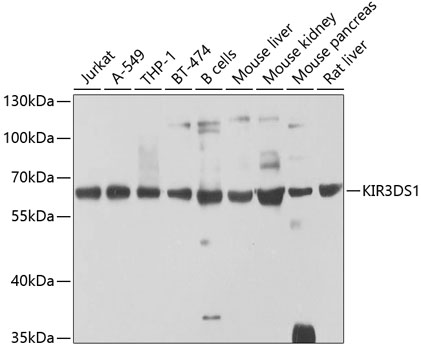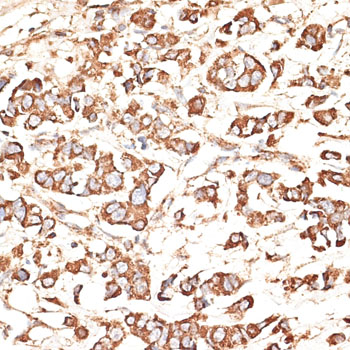Cell Biology Antibodies 12
Anti-KIR3DS1 Antibody (CAB9936)
- SKU:
- CAB9936
- Product Type:
- Antibody
- Applications:
- WB
- Applications:
- IHC
- Reactivity:
- Human
- Reactivity:
- Mouse
- Reactivity:
- Rat
- Host Species:
- Rabbit
- Isotype:
- IgG
- Research Area:
- Cell Biology
Description
| Antibody Name: | Anti-KIR3DS1 Antibody |
| Antibody SKU: | CAB9936 |
| Antibody Size: | 20uL, 50uL, 100uL |
| Application: | WB IHC |
| Reactivity: | Human, Mouse, Rat |
| Host Species: | Rabbit |
| Immunogen: | Recombinant fusion protein containing a sequence corresponding to amino acids 80-340 of human KIR3DS1 (NP_001077008.1). |
| Application: | WB IHC |
| Recommended Dilution: | WB 1:500 - 1:2000 IHC 1:50 - 1:200 |
| Reactivity: | Human, Mouse, Rat |
| Positive Samples: | Jurkat, A-549, THP-1, BT-474, B cells, Mouse liver, Mouse kidney, Mouse pancreas, Rat liver |
| Immunogen: | Recombinant fusion protein containing a sequence corresponding to amino acids 80-340 of human KIR3DS1 (NP_001077008.1). |
| Purification Method: | Affinity purification |
| Storage Buffer: | Store at -20'C. Avoid freeze / thaw cycles. Buffer: PBS with 0.02% sodium azide, 50% glycerol, pH7.3. |
| Isotype: | IgG |
| Sequence: | FNMS PVTT AHAG NYTC RGSH PHSP TGWS APSN PMVI MVTG NHRK PSLL AHPG PLVK SGER VILQ CWSD IMFE HFFL HKEW ISKD PSRL VGQI HDGV SKAN FSIG SMMR ALAG TYRC YGSV THTP YQLS APSD PLDI VVTG LYEK PSLS AQPG PKVQ AGES VTLS CSSR SSYD MYHL SREG GAHE RRLP AVRK VNRT FQAD FPLG PATH GGTY RCFG SFRH SPYE WSDP SDPL LVSV TGNP SSSW PSPT EPSS KSGN LRHL H |
| Gene ID: | 3813 |
| Uniprot: | Q14943 |
| Cellular Location: | Cell membrane, Single-pass type I membrane protein |
| Calculated MW: | 42kDa |
| Observed MW: | 60kDa |
| Synonyms: | KIR3DS1, CD158E2, KIR-123FM, KIR-G1, NKAT-10, NKAT10 |
| Background: | Killer cell immunoglobulin-like receptors (KIRs) are transmembrane glycoproteins expressed by natural killer cells and subsets of T cells. The KIR genes are polymorphic and highly homologous and they are found in a cluster on chromosome 19q13.4 within the 1 Mb leukocyte receptor complex (LRC). The gene content of the KIR gene cluster varies among haplotypes, although several 'framework' genes are found in all haplotypes (KIR3DL3, KIR3DP1, KIR3DL4, KIR3DL2). The KIR proteins are classified by the number of extracellular immunoglobulin domains (2D or 3D) and by whether they have a long (L) or short (S) cytoplasmic domain. KIR proteins with the long cytoplasmic domain transduce inhibitory signals upon ligand binding via an immune tyrosine-based inhibitory motif (ITIM), while KIR proteins with the short cytoplasmic domain lack the ITIM motif and instead associate with the TYRO protein tyrosine kinase binding protein to transduce activating signals. The ligands for several KIR proteins are subsets of HLA class I molecules; thus, KIR proteins are thought to play an important role in regulation of the immune response. Alternatively spliced transcript variants encoding different isoforms have been found for this gene. |
| UniProt Protein Function: | KIR3DS1: Receptor on natural killer (NK) cells for HLA-C alleles. Does not inhibit the activity of NK cells. Belongs to the immunoglobulin superfamily. |
| UniProt Protein Details: | Protein type:Membrane protein, integral Chromosomal Location of Human Ortholog: 19q13.4 Cellular Component: plasma membrane Biological Process: innate immune response |
| NCBI Summary: | Killer cell immunoglobulin-like receptors (KIRs) are transmembrane glycoproteins expressed by natural killer cells and subsets of T cells. The KIR genes are polymorphic and highly homologous and they are found in a cluster on chromosome 19q13.4 within the 1 Mb leukocyte receptor complex (LRC). The gene content of the KIR gene cluster varies among haplotypes, although several "framework" genes are found in all haplotypes (KIR3DL3, KIR3DP1, KIR3DL4, KIR3DL2). The KIR proteins are classified by the number of extracellular immunoglobulin domains (2D or 3D) and by whether they have a long (L) or short (S) cytoplasmic domain. KIR proteins with the long cytoplasmic domain transduce inhibitory signals upon ligand binding via an immune tyrosine-based inhibitory motif (ITIM), while KIR proteins with the short cytoplasmic domain lack the ITIM motif and instead associate with the TYRO protein tyrosine kinase binding protein to transduce activating signals. The ligands for several KIR proteins are subsets of HLA class I molecules; thus, KIR proteins are thought to play an important role in regulation of the immune response. Alternatively spliced transcript variants encoding different isoforms have been found for this gene. [provided by RefSeq, Aug 2013] |
| UniProt Code: | Q14943 |
| NCBI GenInfo Identifier: | 2833258 |
| NCBI Gene ID: | 3813 |
| NCBI Accession: | Q14943.1 |
| UniProt Related Accession: | Q14943 |
| Molecular Weight: | 42,902 Da |
| NCBI Full Name: | Killer cell immunoglobulin-like receptor 3DS1 |
| NCBI Synonym Full Names: | killer cell immunoglobulin like receptor, three Ig domains and short cytoplasmic tail 1 |
| NCBI Official Symbol: | KIR3DS1 |
| NCBI Official Synonym Symbols: | KIR-G1; NKAT10; CD158E2; NKAT-10; KIR-123FM |
| NCBI Protein Information: | killer cell immunoglobulin-like receptor 3DS1 |
| UniProt Protein Name: | Killer cell immunoglobulin-like receptor 3DS1 |
| UniProt Synonym Protein Names: | MHC class I NK cell receptor; Natural killer-associated transcript 10; NKAT-10 |
| Protein Family: | Killer cell immunoglobulin-like receptor |
| UniProt Gene Name: | KIR3DS1 |
| UniProt Entry Name: | KI3S1_HUMAN |
View AllClose









